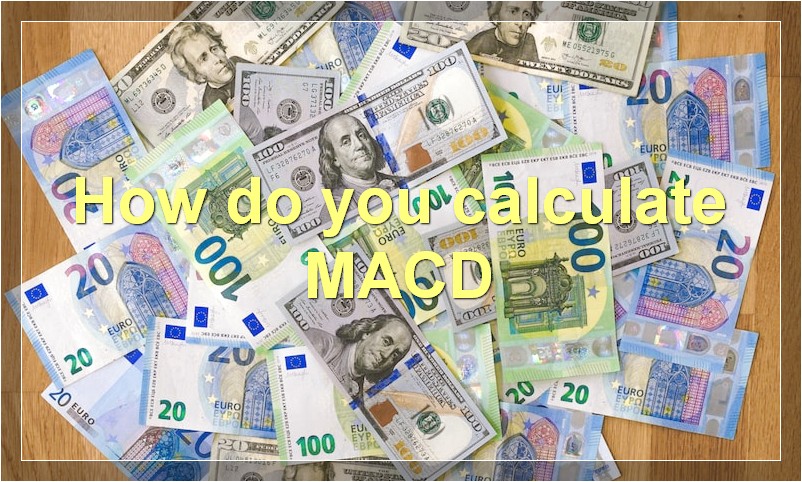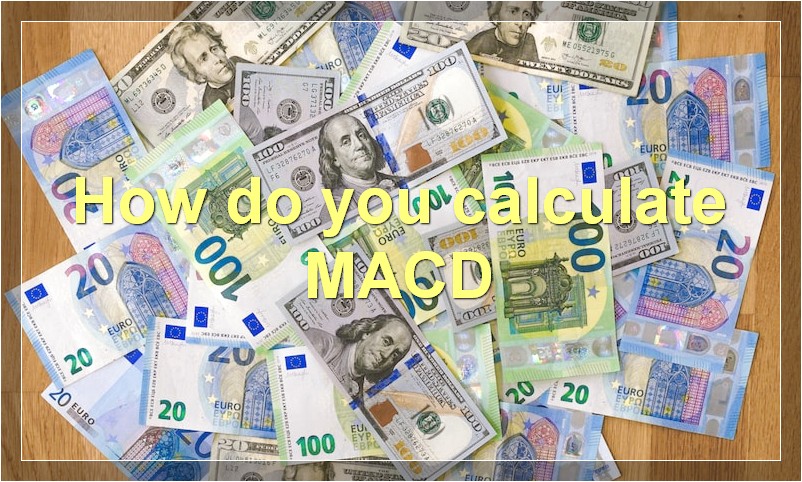Many traders believe that the MACD is one of the most reliable indicators available. In this comprehensive guide, we will show you how to use the MACD to improve your trading results.
What is MACD
MACD is a technical analysis indicator that stands for Moving Average Convergence Divergence. MACD is used to gauge the strength of a current trend and can be used as a leading indicator to predict future price movements.
MACD is calculated by subtracting the 26-day exponential moving average (EMA) from the 12-day EMA. A nine-day EMA of the MACD, called the “signal line”, is then plotted on top of the MACD line, which can function as a trigger for buy and sell signals.
MACD is a popular tool among traders and investors because it is easy to interpret and can be used in conjunction with other indicators to make informed trading decisions.
The MACD indicator can be used to identify bullish and bearish market momentum, as well as potential overbought and oversold conditions. MACD signals are generated when the MACD line crosses above or below the signal line. A bullish MACD crossover occurs when the MACD line crosses above the signal line, while a bearish crossover occurs when the MACD line crosses below the signal line.
When the MACD line is above the signal line, it indicates that the 12-day EMA is trading above the 26-day EMA, which is considered a bullish signal. Conversely, when the MACD line is below the signal line, it indicates that the 12-day EMA is trading below the 26-day EMA, which is considered a bearish signal.
The MACD indicator can also be used to identify potential overbought and oversold conditions. A stock is considered to be overbought when the MACD line is above the signal line and oversold when the MACD line is below the signal line.
How do you calculate MACD

The MACD indicator is a momentum oscillator that measures the difference between two moving averages. The MACD is calculated by subtracting the 26-period moving average from the 12-period moving average. The MACD line is then plotted on a separate chart above or below the price chart, and the signal line is plotted as a 9-period exponential moving average of the MACD line.
The MACD line is used to identify trend changes and generate buy and sell signals. A buy signal occurs when the MACD line crosses above the signal line, and a sell signal occurs when the MACD line crosses below the signal line. The MACD can also be used to identify overbought and oversold conditions. An overbought condition occurs when the MACD line is above the signal line and indicates that the market may be due for a correction. An oversold condition occurs when the MACD line is below the signal line and indicates that the market may be due for a rally.
What is the difference between MACD and other technical indicators
There are a number of technical indicators that stock market analysts use to predict future price movements. MACD is one of the most popular indicators, but there are others that are also used quite frequently. The main difference between MACD and other technical indicators is that MACD measures the relationship between two moving averages, while most other indicators only use one. This makes MACD a more reliable indicator for many analysts.
What are the benefits of using MACD
The MACD is a momentum indicator that shows the relationship between two moving averages of prices. The MACD indicator can be used to identify trends and momentum, as well as to signal when a trade entry or exit may be appropriate.
Are there any drawbacks to using MACD
There are a few potential drawbacks to using MACD as a trading signal. First, MACD is a lagging indicator, which means it will often give signals after the move has already begun. This can result in missed opportunities or false signals. Second, because MACD uses moving averages, it is prone to giving false signals during periods of consolidation or choppy market conditions. Finally, MACD signals are not always accurate, and like all technical indicators, they should be used in conjunction with other forms of analysis before taking a trade.
What are some common ways to interpret MACD

MACD, or Moving Average Convergence Divergence, is a technical analysis tool that traders use to identify changes in momentum. MACD is calculated by subtracting the 26-period Exponential Moving Average (EMA) from the 12-period EMA.
The most common way to interpret MACD is by looking at the histogram. The histogram represents the difference between the MACD line and the signal line. When the MACD line is above the signal line, it indicates that the 12-period EMA is above the 26-period EMA, and vice versa.
Another way to interpret MACD is by using divergences. A bullish divergence occurs when the MACD line makes a higher high while prices make a lower high. This indicates that although prices are not making new highs, momentum is. Bullish divergences often lead to price breakouts.
A bearish divergence occurs when the MACD line makes a lower low while prices make a higher low. This indicates that although prices are not making new lows, momentum is. Bearish divergences often lead to price breakdowns.
What are some common trading strategies that use MACD
There are a few different ways to trade with MACD, but some common strategies are:
1. Crossover – This is when the MACD line crosses over the signal line. This is usually seen as a buy signal.
2. Divergence – This is when the MACD line diverges from the price action. This can be seen as either a buy or sell signal depending on the direction of the divergence.
3. momentum – This is when the MACD line is moving in the same direction as the price action. This is usually seen as a sign of momentum and can be used as a buy or sell signal.
Can MACD be used to trade other markets besides stocks
MACD is a versatile tool that can be used to trade a variety of markets. In addition to stocks, MACD can be used to trade forex, futures, and options. While MACD is primarily used as a trend-following indicator, it can also be used to identify overbought and oversold levels. MACD is a popular indicator among traders and investors alike, and can be a valuable addition to any trading toolkit.
How often do you need to recalculate MACD
There is no definitive answer to this question as it depends on a variety of factors, including the time frame you are using, the volatility of the markets, and your personal trading style. However, as a general guideline, most traders will recalculate MACD every few days or so in order to keep up with the latest market conditions.
Does the inputs for MACD matter
MACD, or Moving Average Convergence Divergence, is a technical analysis indicator that measures the relationship between two moving averages of prices. MACD uses exponential moving averages (EMA), which give more weight to recent data, while MACD histograms use simple moving averages (SMA), which give equal weight to all data. MACD is calculated by subtracting the 26-day EMA from the 12-day EMA. A 9-day EMA of MACD, called the “signal line”, is then plotted on top of MACD. When MACD crosses above the signal line, it is a bullish sign, indicating that prices are likely to rise. Conversely, when MACD crosses below the signal line, it is a bearish sign, indicating that prices are likely to fall. The inputs for MACD (the number of days used in the moving averages) are not as important as the direction of the moving averages.

